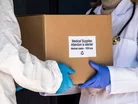Scaling up operations during Covid-19 with technology

It's no secret that the pandemic has uprooted every cornerstone of our day-to-day life. Consequently, the spread of COVID-19 has required our global healthcare network to rethink operational strategies to meet the crisis' demands. With the pandemic overwhelming healthcare systems – locally, nationally and globally– the global healthcare network had to rapidly respond to the challenges and upscale their healthcare capabilities to meet the pandemic's unprecedented demands.
As a manufacturer of key medical equipment, the global pandemic has obviously placed Marathon Medical in a position to help healthcare professionals and their patients in a time of extreme need. However, in a practical sense, it also posed a significant logistical and business challenge: how could we scale our operations quickly enough to meet the need, without either diminishing the quality of these vital products or putting our business in future jeopardy.
This was a challenge facing healthcare suppliers across the globe. Hospitals were running out of ventilators and had to turn away patients due to lack of supplies. Due to this increased demand, analysts predict that the medical supplies market size will reach $100 billion by 2021, a 13.4 per cent increase from 2019.
For us, seamlessly scaling business efforts was necessary at the onset of the pandemic to rapidly increase our production of the most critical items, such as surface disinfectants and ventilators, to the broader medical community.
This obviously posed significant challenges for Marathon Medical, but also for healthcare providers who still needed certainty around the delivery – and future availability – of vital medical equipment.
To tackle this unprecedented challenge, we needed to be nimble enough to pivot support for our customers, which required us to forecast the demand for equipment and supplies, manage inventory effectively and distribute rapidly. This business challenge was only further compounded by the unwavering need to keep up with demand without compromising or reducing quality and safety.
To do this, we placed a significant focus on resource planning and leaned heavily on our cloud-based business management software. We worked in partnership with Sage before the pandemic to help optimize our business, but having ready access to the key data needed to make informed decisions and rapidly scaling our operations has been critical over the past seven months.
Not only did it help us ensure we could develop and deliver the supplies needed to meet the increased demand, but on the distribution side we are able to supply the right number of products, forecast demands and provide accurate, up-to-date information.
It’s this ability to plan – and adjust quickly as needed – which has helped us service the most extensive integrated health care system in the United States, The Veterans Health Administration (VHA), without skipping a beat. It’s also one of the reasons why the federal government was relying on us to provide over $27 million worth of medical syringes, vials and needles to administer a billion COVID-19 vaccines, when one becomes available.
In addition to scaling to meet the immediate global crisis, it was also important that we weren’t making decisions that put our business future at risk or could impact our ability to continue delivering the equipment our existing customers still needed. In this regard, being confident in financial software to automate and streamline invoice and bill collection, minimizing record-keeping redundancies and errors, as well as quantify budget planning has been critical. This allowed us to remain focused on the present crisis and how we can help, while remaining confident that the future of our business remains solid.
Ultimately, technology is enabling us to meet our end of the contract with the Federal Government, and we are honored to be the medical equipment supplier for such an important, life-changing program. Our manufacturers also move us forward; it is their support and commitment to our align mission, and their technology in place to keep the supply chain moving, that enables us to provide excellent products to the broader healthcare community.
- Cencora's Healthcare Bio Logistics StrategyProcurement & Supply Chain
- Supplies & Scope 3: This Week's Top 5 Stories in HealthcareProcurement & Supply Chain
- The Renewables Drive Helping Merck Smash its Climate GoalsSustainability
- How Is Novo Nordisk Cutting Its Scope 3 Emissions?Sustainability



